The lack of news from New Zealand over the past 5 months is not meant to reflect a lack of news, just a lack of time. But I mean to remedy this.

First things first. Shortly after our landfall in NZ I visited a doctor to confirm the suspected…holy cow, I’m pregnant! With a due date of June 20th, that places conception somewhere in Tonga. Hmmm, I picture Pangaea at anchor, nestled in a coral garden before an uninhabited tropical island. I suppose that lends itself to romance. Funny what happens when you have so much time on your hands. We settled into our surprise, fought back irrational fears, accepted the rational ones, and faced the news with a sense of adventure. That is, after all, what this year and a half has been all about. We found ourselves an ob-gyn, Dereck Souter, who endeared us with his warmth, intelligence, and a hilarious chuckle that really sealed the deal. Aside from a touch of the queasies, a distaste for meat, and a 24-hour puke-fest set off by the slightest motion at sea, I felt pretty normal otherwise. As a consequence it took some time for the reality to set in. We headed south to the big metropolis to await an oncoming wave of visitors. It seemed a good time to spread the news (and avoid the sea).
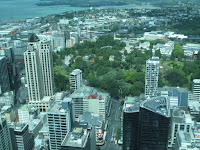
So, there we were (and still are, as of this writing): Auckland. A city. Oooh - the glory of convenience and accessibility. Flashing lights, skyscrapers, scantily clad fashionistas, traffic. I wouldn’t call Auckland a polluted city, as far as cities go, but my lungs noticed an immediate change in the air and I developed a nice little cough. Hard to compete with a mid-ocean breeze for clean and fresh. Strangely, and despite our downtown location, we found the internet frustratingly hard to tap into from the boat. But, we absolutely delighted in our culinary options with the grocer’s selection of vegetables at our local market, not to mention quality meats found in pre-freezer burn condition. Oh, and the dairy: fresh milk (enough of this boxed UHT crap), yogurt and cheese, oh my! A break from our staple diet of cabbage, carrots and potatoes, and all things dried, canned and preserved. A city-sized swarm of restaurants beckoned with a cosmopolitan array of cuisines (especially Asian – no surprise). Our heads were spinning with options, but rather than shrink away in sensory-overload we did a little dance of joy. I’ve never been one to complain about choice and quality when it comes to food.

And yet, the city drew us here with a job to be done: find a broker and prepare our beloved Pangaea to brave the vagaries of the market. Was it planned? Kind of. We knew our travels would need a stopping point and we had never planned for points beyond NZ. But to bring her back to Seattle? Not unheard of…just difficult. You see, we took the easy way down here, ie downwind, via the trades. Going back up is just that, up—upwind and against the current. We had always toyed with the idea of selling her here in NZ, a venue that has proven to be as receptive as we had anticipated. That is, Pangaea is a Kiwi boat – both built and designed. Hamish, her first owner, raced her through the late 80’s and 90’s as Jessie James, and we found that she is well-remembered and readily recognized here in Auckland. We were tickled by the attention she received, and Aucklanders were tickled that we cruised her, a race boat, all the way here to NZ. Pangaea, née Jessie James, received a warm welcome. And yet, does that mean we can sell her here in this relatively small market, a race boat now loaded down with cruising amenities? A race boat less likely to be competitive with the youngsters out there plying the waters of the Hauraki Gulf? Well, with a bun in the oven, so to speak, there was a little more reason to put her on the market after all. A couple years unemployed leaves the coffers a little bare. A little money in our pocket for our return to Seattle and the working world would go a long way toward settling in for the changes on our horizon.
I need not mention that the recent upheaval in the economy, which began heaving shortly before our arrival in NZ, has added a layer of complexity to our plans to sell Pangaea. No doubt the market is not ripe to sell a boat, ie a luxury item. This stark reality, alongside a weakening NZ dollar, has left us dubious that a sale at a price we can live with is in Pangaea’s near-future. In other words, we’re crossing our fingers but not holding our breaths.

Auckland itself? Green, bustling, seaside, clean, international, friendly, manageable in size and girth. It struck me, and strikes me still, very much like Seattle, minus the mountains. Even the summertime weather has its parallels to my damp hometown. It surely surpasses Seattle in the local addiction to SAILING, however. You see, Seattle boasts the highest boat ownership per capita in the US. Well, Auckland boasts the highest in the world, and it shows. The marinas are expansive and packed, and the Hauraki Gulf is teeming with boats, both sail and power. Wednesday and Friday nights (and of course every weekend) find many Aucklanders out on the water, competing, then drinking. Ben was in his element. He took to gawking and drooling at the race boats during his daily strolls along the Viaduct waterfront. He crewed on Moonduster for Bay of Islands race week, accepted invitations to crew on our Westhaven Marina neighbors’ yacht Wednesday nights, helped decommission BT, the crippled Vendée Globe Open 60, and later we anchored out mid-Gulf to watch the buoy races of the Louis Vuitton Pacific Series. (The Kiwis won, in case you’re wondering). World class stuff – very cool.

What about Aucklanders (and Kiwis in general)? Open, helpful, welcoming and friendly, with not a touch of the insincere; proud; quick to laugh; boisterous; easy-going. Quite fond of drink, with a strange predilection for costumes, at any time of year. Funny, while I wouldn’t call the Kiwi accent thick, the language is obscured by a serious nation-wide mumbling habit. So be it.

Mid-December my mom arrived from Seattle to spend a summer-time Christmas with us in the southern hemisphere. Our first visitor since Mexico to the Marquesas! Lovely for Ben and I to get a break from ourselves, and each other. (You must understand we’ve had a lot of solo, one-on-one time to contemplate each other’s navels – thus the pregnancy). Despite the vast distance traveled, the time change was only 3 hours, making her jet-lag adjustment pretty tolerable. We relaxed in style in a downtown Auckland hotel for the first few nights. Aaaaahhh….a bed (and we opted for King-size)…oooohhhh….a shower that doesn’t require a coin! We drank lattes in the morning, explored the city by day, sampled local restaurants by night. Talked, chatted and gossiped as girls are wont to do. It was great to see my mom! While Ben single-handed Pangaea back up to the Bay of Islands, mom and I drove the car up to Kerikeri where we settled into a cozy B & B, admiring the lush, Eire-like, sheep-peppered pastoral countryside along the way.
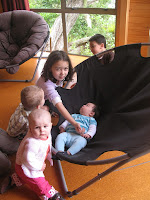
Christmas approached and we awaited the rest of the family, with the Souquets en route from disparate points around the globe. And, oi, did the members of the Souquet family brave Odyssean obstacles to get here. First to miss his flight was Jonathan, who had left his American passport back home in Blackpool and learned that, though his touch-down in the States was nothing more than a lay-over between London and Auckland, he wouldn’t be allowed through customs an American citizen on a French passport. Sharon, an anxious flyer, braved the day-plus journey with baby Evie and toddler Kyan in tow on her own, with Jacques and Marianne, just in from France, along to help. Jonathan took an extra flight to meet us in the Bay of Islands, and arrived a day late, but made it all the same. A 12-hour time difference was harder for our European visitors to surmount, but accomplished nonetheless. The Seattleites fared worse, as it turns out the Pacific Northwest had just been subject to the snow storm of the decade. Ooooh, bad timing for folks with holiday plans. Despite exhaustive efforts, hours on the phone and fraying nerves, Tim and the 5 Smiths failed to find alternative flights from Seattle, or Vancouver, or Portland….. In the end they braved the elements, climbed in the car (not a single rental was to be had through the Puget Sound region), and made the long, 19-hour journey to San Francisco to catch a flight there. What a hassle! Luckily Chloé, Théo and tiny, new Daphné went with the flow. Two days late and several dollars short, but happily welcomed on Christmas morning.

We stayed on the shores of Parekura Bay, with Pangaea anchored alongside, in a holiday house rental spacious enough to accommodate the 15 of us. We packed the Christmas/New Year holiday with day trips around the lovely Bay of Islands: a day cruise on Pangaea, a dolphin-seeking tour, kayaking, caving for glow worms, scuba diving, Maori entertainment, sight-seeing and dune-boarding, always peppered with festive holiday family meals, games and, of course, presents! My mom left a couple days before the New Year and, after some time spent exploring Auckland, the Souquets scattered back across the globe.
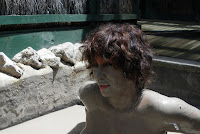
We relocated ourselves and Pangaea back into the marina in Auckland and had a few days to tend to ourselves before our next guest: Liz, arriving all the way from France, this time via Hong Kong. (Really it’s six of one, half dozen of another, as France lies pretty much exactly opposite NZ on the globe – just as well go one way as the other). Liz arrived a little under the weather, having picked up something flu-like in China, and sharing it with us. That set us back a little but we re-energized and saw some of the sights more local to Auckland, including a day trip to the coast, and a few days south in Rotorua, to see the geothermal parks and soak in sulfur and mud. As per usual, most of our time with Liz was spent chatting, strolling and philosophizing, lovely and relaxing as always.

Before Liz’s departure we were joined by Reme and David, our friends the Spanish expatriates from Shanghai, an impromptu visit that we were lucky they could squeeze in over the Chinese New Year. We visited nearby vineyards and coastline, then cruised to Waiheke Island in the Hauraki Gulf on Pangaea for a lovely time on the water – it had been awhile! And by now, trimester 2, with my belly now quietly displaying its contents, the sea didn’t turn my stomach. What a relief.

We dropped Reme and David at the airport, and stuck around to pick up our friend Denny, flying in from Portland. Again, catching up was the order of the day, as there was plenty of that to be done, starting with good ol’ fashioned gossip, and spanning to include stories of travels, relationship travails, veterinary medicine, and strategizing our NZ explorations. These included the geothermals, Waitomo caves, coast watching, beach walking, sailing, hiking and, of course, cooking and eating, as always the highlight of the day, especially with Ben at the galley stove. During Denny’s visit I had my 20-week ultrasound, finding that the little creature in my belly was most likely human (I’d kinda been rooting for a kitten, specifically a fluffy one) and a girl! Now we could start the name game in earnest. Ben had taken to using a new name for each reference made to the baby in conversation. Funny enough, Cunegonde and Consuela didn’t make the cut.
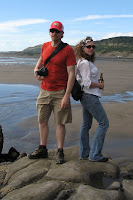
Denny set off for solo travels on the South Island and we set to several boat-related and other chores put off for some time by our slew of visitors. Little more than a week went by after Denny’s departure before we hosted our next guests: Jennifer and Rod in from Seattle. The highlight of their visit was our long-anticipated journey together to the South Island, New Zealand’s other half. We rented a car in Christchurch and made our way to the southern tip of the island, to visit Rod’s hometown on the outskirts of Invercargill. We visited seaside sights as we hopped down the coast, and then veered north to Fiordland, home to mountains and, naturally, fiords. We hiked from here to there, through lush forests, up rocky mountain-sides, along coastal bluffs, around placid lakes and alongside deafening waterfalls. By this time, my uterus was competing for space, winning the war against my other organs, including my diaphragm. I found it harder to catch my breath but managed to heave myself about, a step or two behind my friends. Unfortunately their time was short so we delivered them back to Dunedin for their flight home, and turned back to Queenstown, capital of adrenaline sports, to exchange our rental car for a campervan.

We explored Queenstown and neighboring Glenorchy, home to hobbits, elves, ents, dwarves and wizards. We didn’t stumble upon Gollum, or stoop to pick up any magical rings, but we marveled in the rugged beauty of Middle Earth. Next stop: Fox Glacier on the South Island’s west coast. Sleeping in the campervan along the way we discovered why no one really lives on the west coast – a fear of blood-letting! After a fitful night of buzzing in our ears, we awoke to find the inside of our camper had been colonized by mosquitoes. And I don’t mean just a few. First we freaked out, opening the van’s side door in a panic, only to be enveloped, seriously, by a swarm of fucking sand flies that were stupid enough not to figure out how to violate our sleeping quarters overnight. After flailing and gyrating, which didn’t manage to dislodge these more vicious blood-suckers, we hastily retreated back into our nest of mosquitoes. We manually squashed upwards of 200 of the blood-suckers. They appeared sluggish compared to the sand flies, likely in a post-prandial stupor because they had already feasted overnight.

We finally made it to Fox Glacier, scratching ourselves raw but up for new adventures. This region is relatively free of the otherwise omnipresent sheep and pastureland, draped in trees, mosses and ferns in a lush exuberance of temperate rain forest. Slicing, inching and crushing a swath down through the greenery are Fox and Franz Josef Glaciers, among others peppered throughout the Southern Alps. We signed up for a guided hike on Fox Glacier, laced up the boots provided and clamped on our cramp-ons. A 4-plus hour hike took us along the valley floor, along the edge of the glacial river, scootching around rock falls, and up the side-edge (not the temperamental front) of the glacier. It was otherworldly and sooooo cool!
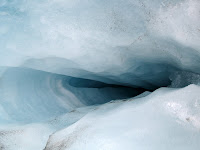
The weather was iffy but managed to hold; rain threatened but the sun briefly won out. While ice-hiking we witnessed the aftermath of a significant collapse at the glacier’s terminal face. We weren’t close to that edge so we couldn’t see it directly from our vantage point, but there were some brave/stupid souls close by the face on the valley floor. They managed to get out of the way as the wall of ice fell, and then flooded the river flowing from the glacier’s terminus. We watched as huge boulders of ice flowed downstream and the river expanded to flood the hiking trail we had taken to approach the glacier on the way up. No one hurt – what earth-shattering excitement!! We made a detour around the flooded zone on the way down. (We learned the following week that someone perished in a rock fall hiking up to that glacier). And a couple people were crushed just a few weeks before. Dodgy things, glaciers.
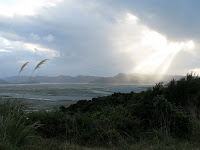
Onward we drove further north, via Haast Pass, to Nelson, where we stayed the night on MV New Paige, paying a visit to our cruising friends Joan, Roger and Paige, the Allards. We enjoyed a home-cooked meal, friendly company, a hot shower (and the use of their washer/dryer!). The next day we drove to Abel Tasman Park, hiked to Pu Pu Springs and a short way along Farewell Spit. The park surely deserved more time than we gave it but our time was ticking away so we left the next day for lovely Marlborough Sound on the South Island’s northeast coast, home to quaint little Picton and NZ’s most famous vineyards (growing predominantly sauvignon blanc). Ben did a little wine-tasting, and I a little wine-sipping, and then we closed the loop as we ventured south again, back to Christchurch along the island’s east coast.

Now we find ourselves back in Auckland, bracing ourselves for the bittersweet: a mix of emotions as we look forward to seeing our long lost loved ones, and bid a sad farewell to Pangaea and her adventures. It may be our last glimpse of her, now that she competes in this shaky market for a buyer. Or, she may be our reason for a future return to New Zealand, to bring her back home. We shall see…. ;-)


